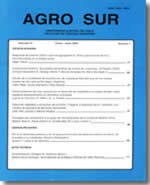Effect of soil structure on water movement in a soil catena
Main Article Content
Abstract
In order to describe the water flow in a soil catena, undisturbed soil samples (vertical and horizontal with respect to the soil surface) were collected in different soil areas and positions of a typical soil catena of the Weichselian moraine region in Northern Germany. The water retention curve and the saturated hydraulic conductivity (kf) were determined. The water flow in the hill slope was simulated considering rainfall, evapotranspiration and the hydraulic properties of the soil horizons.
Hydraulic conductivity was strongly related to the soil structure, the volume of macropores, the interconnection and continuity between pores. The formation of a plate structure in the plough pan leads to anisotropy of saturated hydraulic conductivity (kf-H > kf-V) which can conduct a preferential flow in the catena as represented in the simulation.

